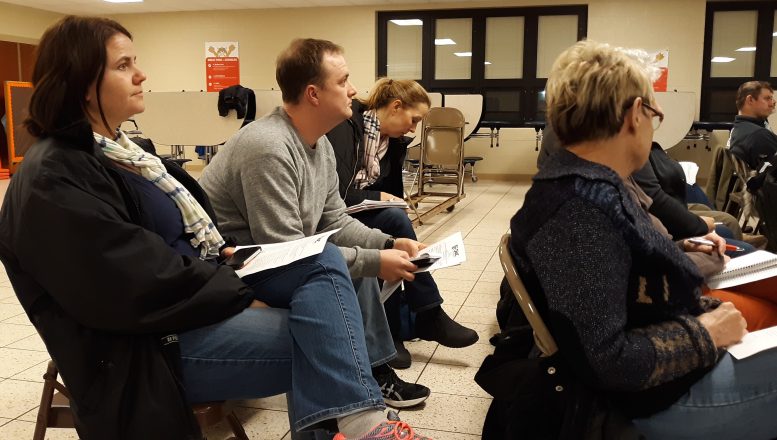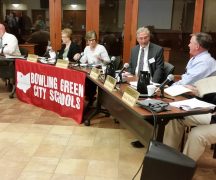By JAN LARSON McLAUGHLIN
BG Independent News
It’s not just the dollars and cents – but also who should foot the bill for school buildings – that the school finance task force is debating.
The task force met Wednesday evening at Crim Elementary School to look at some preliminary costs for district taxpayers. The questions are many – how much should the district spend on new or renovated buildings; what type of tax should be used; and how many years should a bond issue cover.
“What’s best for the majority of people,” asked David Conley, the district’s financial consultant with Rockmill Financial Inc.
But task force member Barb Belleville suggested the task force view it differently.
“How about how to make sure everyone pays their fair share,” she said.
Another task force member suggested yet another perspective.
“Can we just look at affordable ways for our community to support this,” Tracy Hovest said.
No matter what type of tax is sought by the district, there will be some residents more burdened than others, Conley said.
“It’s up to you all to sort of evaluate what you consider the right way for the district,” he said. “It doesn’t matter which tax structure you pick – it will burden someone more than someone else. It’s not a fair system.”
Conley plugged in various numbers to calculate how much the average Bowling Green School District taxpayer would pay with different options. He stressed that all the numbers were very preliminary.
“We’re just experimenting,” he said.
All of the calculations were based on the goal of raising $41 million (which is the maximum amount being considered so far by the school facilities task force.) Based on that goal, the following costs to the average taxpayer were calculated:
- $181.50 per year ($15.12 per month) if a property tax was used, with bonds over a 37-year period.
- $256.29 per year ($21.36 per month) if property tax and traditional income tax both paid for half of the $41 million.
- $331.08 per year ($27.59 per month) if a traditional income tax paid the entire $41 million.
- $662.15 per year ($55.18 per month) if an earned income tax paid the entire $41 million.
Task force member Grant Chamberlain said the earned income tax would be “performance based,” so more fair for taxpayers.
However, Ben Otley, another task force member, and Conley pointed out that earned income taxes do not tax capital gains, partnerships, pensions, and businesses claiming depreciation. It would allow less scrupulous large landowners to get out of paying taxes for the schools.
“In reality they are making money,” Otley said. But they may be able to skirt paying the taxes.
Task force member and former school board member Ellen Dalton also voiced her opposition to the earned income tax.
“I am so against it, because I wouldn’t pay anything,” said Dalton, who is retired. “That’s not right.”
To help the task force reach a solution, Conley shared numbers comparing Bowling Green with neighboring school districts.
Bowling Green ranks fifth out of 16 districts for the amount paid per household for the schools. Toledo households pay the lowest at $1,147 a year, and Ottawa Hills pays the highest at $7,373 a year.
Bowling Green, where households average $1,866 a year for schools, is lower than North Baltimore, Eastwood, Oregon, Otsego, Northwood, Rossford, Springfield, Maumee, Sylvania, Perrysburg and Ottawa Hills.
Part of that ranking, Conley said, is due to Bowling Green not passing any bonds or new operating money in the last nine years.
“The community has benefitted from the delay in passing something,” he said.
The next comparison looked at how much of the average household income is going to schools. The lowest were Lake, Elmwood, Toledo, Otsego and Eastwood. Bowling Green, ranked in sixth place, with 2.8 percent of income going toward schools. That is less than Oregon, Northwood, North Baltimore, Washington Local, Springfield, Rossford, Sylvania, Perrysburg, Maumee and Ottawa Hills.
Otley noted that for a community to be competitive for economic development, good schools make a big difference.
“Where are people choosing to live when they move into the area – and why is that,” he asked. “They’re not staying away from Perrysburg because of the taxes.”
Conley agreed that new, attractive school buildings with good curb appeal make a difference to people choosing a community.
Conley calculated the same tax options, and inserted the amounts into the school rankings to find that:
- If Bowling Green passed a property tax for $41 million, its affordability ranking would move from sixth place to 10th place.
- If BG passed a traditional income tax for $41 million, its affordability would move from sixth to 14th place.
- If BG passed a combined income and property tax for $41 million, the affordability ranking would go from sixth to 11th place.
Some task force members expressed displeasure that the high school portion of the building projects has been dropped for now. Conley said the board’s decision to put the high school on hold makes sense.
“The board is just trying to be proactive here,” he said, noting the district’s need to also renew three other levy issues in the next few years.
“It’s almost like suicide” for the bond issue if it’s too large, Conley said. “You need money to operate this district,” and going for too big of a bond issue is “really risky.”
The task force needs to look at how different taxes affect different portions of the school district, Conley said.
Tax returns from the district show that 5,907 local residents earn less than $25,000 a year, and another 8,868 make less than $50,000 annually.
“When you start talking about an income tax, you all should know you have a lot of people in this category,” of earning $50,000 or less, Conley said.
And unlike property taxes, income taxes don’t tax businesses. Businesses currently make up 33 percent of the tax value in the district. So income tax will require individuals to pick up that portion of the costs since businesses don’t.
Conley also discussed questions previously raised about the length of bond issues. Bowling Green was criticized by some for trying 37-year bonds during the last two election attempts.
But Conley pointed out that while shorter terms mean lower interest rates, they also mean bigger monthly payments for taxpayers. The average term for bonds on all the school levies on the ballot last May in Ohio was 35 years.
“The sole reason districts go with 37 rather than 25 years is to get the payments down,” he said.
Conley said bonds can always be paid off early, or can be refinanced for lower rates.
Another issue discussed by the task force was the fact that extra money could be generated by income taxes, since the state will only allow those to be passed in increments of 0.25 percent.
Task force member Richard Strow asked if the additional money raised could be placed in a maintenance fund. Conley said that would be a good idea.
Task force member Wayne Colvin noted the two types of maintenance needed for school buildings – while some are minor expenses, other require big bucks to replace roofs, boilers or technology.
Conley said the additional money generated can be set aside for capital improvements, but suggested that the wording of the bond issue not be too restrictive.
The next meeting of the finance task force will be March 12, at 7 p.m., in Crim Elementary School.


